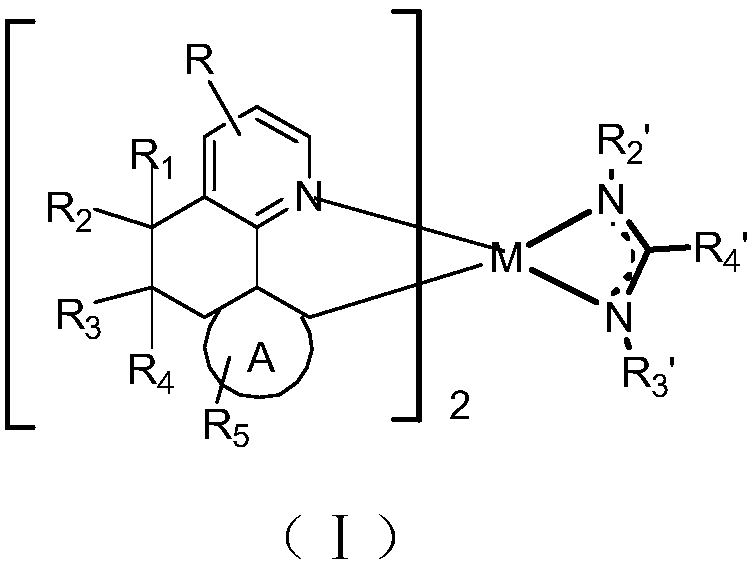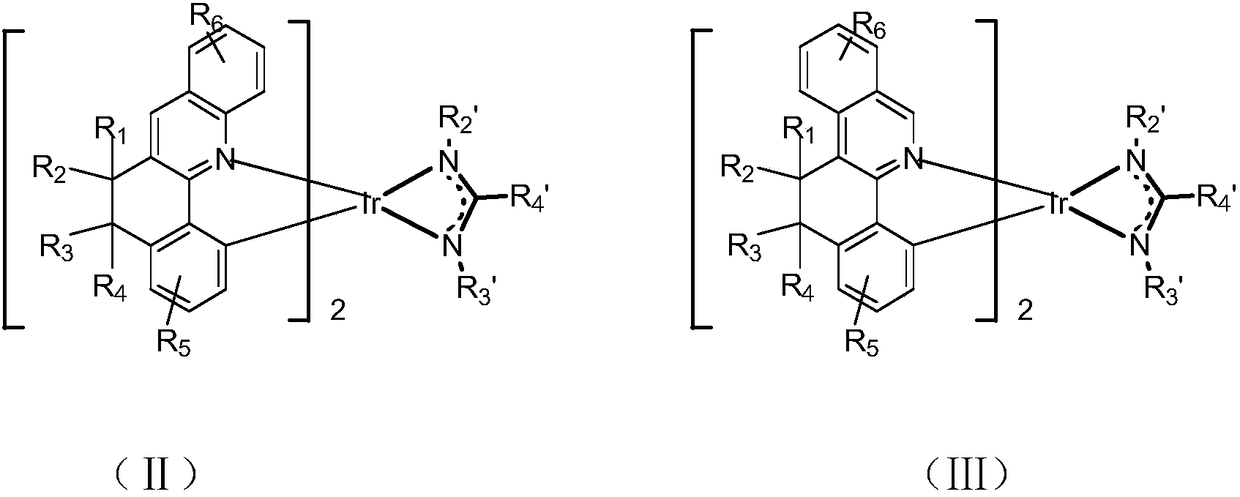Metal complex and organic light-emitting device thereof
A technology of organic light-emitting devices and metal complexes, which is applied in the field of metal complexes and organic light-emitting devices, and can solve problems such as low luminous efficiency, short life, and poor thermal stability of phosphorescent materials
- Summary
- Abstract
- Description
- Claims
- Application Information
AI Technical Summary
Problems solved by technology
Method used
Image
Examples
preparation example Construction
[0079] The preparation method of general formula (III) is as shown above.
[0080] The present invention has no special limitation on the above reactions, and conventional reactions well known to those skilled in the art can be used. The preparation method is simple to operate and easy to produce.
[0081] The present invention also provides the application of the above-mentioned iridium-containing metal complex in an organic light-emitting device. A metal complex of the present invention can be used as a light-emitting layer material in an organic light-emitting device, and the organic light-emitting device includes an anode , cathode and organic functional layer, the organic functional layer comprises at least one layer in hole injection layer, hole transport layer, electron blocking layer, light-emitting layer, hole blocking layer, electron transport layer, electron injection layer; the organic function At least one of the layers contains an iridium-containing metal complex...
Embodiment 1
[0083] Embodiment 1: the preparation of compound 1
[0084]
[0085] Preparation of Intermediate 1-2
[0086] In a 500 mL two-neck round bottom flask, 1-1 (25.0 g, 143 mmol) was dissolved in 120 mL of anhydrous THF. The solution was cooled in an ice-water bath, and then 215 mL of a 1.0 M solution of lithium aluminum hydride (LAH) in THF was added dropwise. After all the LAH was added, the reaction mixture was warmed to room temperature and stirred overnight at room temperature. 10 mL of water was added to the reaction mixture, followed by 7 g of 15% NaOH. An additional 20 g of water was added to the reaction mixture. The organic THF phase was decanted and ethyl acetate was added as a solid. Add to 200 mL and stir, combine ethyl acetate organic portion and THF portion and add Na 2 SO 4 desiccant. Filter and evaporate the mixture. 20 g of a yellow solid was obtained, which was not further purified for the next reaction.
[0087] Preparation of Intermediates 1-4
[0...
Embodiment 2
[0096] Embodiment 2: the preparation of compound 12
[0097] 1-5 in Example 1 was replaced by equimolar 12-5, and the other steps were the same as in Example 1 to obtain the target compound 12.
[0098]
[0099] Mass Spectrum m / z: 1202.90 (calculated: 1202.91). Theoretical element content (%)C 67 h 93 IrN 4 Si 2 : C, 66.90; H, 7.79; Ir, 15.98; N, 4.66; Si, 4.67 The measured element content (%): C, 66.90; H, 7.78; Ir, 15.97; The above results confirmed that the obtained product was the target product.
PUM
 Login to View More
Login to View More Abstract
Description
Claims
Application Information
 Login to View More
Login to View More - R&D
- Intellectual Property
- Life Sciences
- Materials
- Tech Scout
- Unparalleled Data Quality
- Higher Quality Content
- 60% Fewer Hallucinations
Browse by: Latest US Patents, China's latest patents, Technical Efficacy Thesaurus, Application Domain, Technology Topic, Popular Technical Reports.
© 2025 PatSnap. All rights reserved.Legal|Privacy policy|Modern Slavery Act Transparency Statement|Sitemap|About US| Contact US: help@patsnap.com



